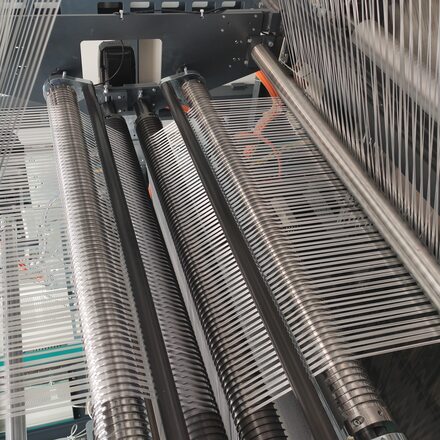Successful test series on the SIM.PLY UD, particularly in the field of personal protection
Low-weight, high-performance UD tapes
KARL MAYER’s SIM.PLY UD was presented to the global composite audience at the ITMA in Barcelona in June 2019 as a machinery for processing glass fibres and polypropylene. Just a few months later, the first customer trials started on the innovative system, which specialises in the production of thermoplastic unidirectional tapes (UD tapes) using fibre spreading technology.
Over the course of the past year, processing tests were stepped up and other material combinations were also used in response to customer requests. Among other things, high-strength polyethylene and regenerated cellulose fibers were used. The finished patterns generate significant interest: enquiries come from Europe in particular, but also from Southeast Asia, especially about the variants made of high-strength polyethylene material, which, provided with a film coating, are attracting attention as innovative solutions for the area of personal protection.
Various test series are now running for this on the SIM.PLY UD at KARL MAYER Technische Textilien’s application centre in Chemnitz, including projects in the field of personal protection.
Multi-layer systems offer high protection and are comfortable to wear
Protective clothing – indispensable in everyday life among others for security personnel and police officers – must be exceptionally comfortable to wear while also providing effective risk protection. For this purpose, protective textiles act as intermediate layers. The integrated prefabricated layer packages are to be made increasingly lighter and thinner for greater comfort, yet must also offer long-term stability against environmental influences such as UV radiation and temperature. In particular, a reduction in the energy absorption and damping capacity must be avoided, and the material must not become brittle. In practice, the protective effect is guaranteed for at least 10 years.
To meet the high requirements, body protection textiles are usually made of polymeric reinforcing threads. The most common of these are variants made of aromatic polyamide (PA), also known as aramid, or ultra-high-molecular-weight polyethylene (UHMWPE). DSM’s Dyneema® is the most widely known product.
The polymeric reinforcing threads are stretched directly after spreading in similar polymeric thermoplastic films or curing polymer dispersions; they are embedded with optimum orientation. Very thin, unidirectional layers are created, which are always layered on top of each other alternating between 0° and 90° fibre orientation to optimise protection. The finished multi-layer protection packages, also known as cross-plies, can consist of up to 140 individual layers.
Single layers with low weight, good fixation and high mechanical performance
The SIM.PLY UD’s spread and film coating technology makes it possible to produce extremely thin and therefore lightweight individual layers. UHMWPE fibres in particular can be spread out so evenly that only two to three individual filaments of the fibre bundles lie on top of each other on average. For the production of protective textiles, PE roving material with a gauge of 800 den (89 tex) or 1600 den (178 tex) is used as the starting material. For fixation, the fibres are coated on one side with a 10-µm-thick PE film, producing single layers with a weight per unit area of less than 40 g/m². What’s more, this creates a firm composite. The basis for this is the same yet differently processed polymers made from the spread fibres and the film. Due to the high-stretching of the fibres, the PE molecular chains form a highly crystalline network during production, which causes the fibres to melt at a slightly higher temperature than the PE film. Given the different melting point, the film can easily be melted during the coating process and fix the fibres that are still temperature-stable, while their exceptionally high performance profile remains unchanged. This sophisticated procedure requires very precise temperature control, as offered by the SIM.PLY UD thanks to its impregnation modules.
First functional samples, next steps
Several samples have already been produced on the SIM.PLY UD as part of customer trials, and these are now being tested for their protective effect and further processed by customers. In addition, cross-ply samples were made by hand at KARL MAYER Technische Textilien’s application centre. To do so, 0° and 90° layer systems were produced manually and laminated on the SIM.PLY UD. The company is working on an automated solution with a suitable laying technique for creating single cross-ply layer. This is based on many years of experience in the field of multi-axial laying technology, which has already been used to develop the successful COP MAX 5, for example. Over the next few months, a test programme will initially be launched to investigate the textile behaviour of such thin and finely spread textile structures with a film coating on one side when they are handled as part of the laying process, and to determine suitable functional principles.
Back to overview

